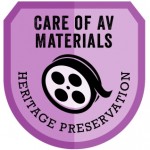Audiovisual collections can run the gamut of formats, from analog audio, film, and video to digital audio, film, video, and optical media. This five-part course will examine the various formats and explore the major issues and challenges in preserving them. A team of national experts will help you navigate the mind-boggling array of AV materials and provide practical advice on identifying, caring for, handling, storing, and accessing them. This course has concluded, but all of its materials from webinar recordings to handouts are available for viewing for free at your own pace.
Webinar 1: Basic Concepts and Principles of Audiovisual Preservation
Wednesday, October 16, 2013, 2:00–3:30 p.m. (EDT)
Instructor: Karen F. Gracy
In this introductory session to the topic of audiovisual preservation, Karen F. Gracy will address the major challenges of caring for analog audio, film, and video collections. Participants will learn about the physical composition and vulnerability of audiovisual formats, find out how best to limit deterioration through appropriate storage environments, and become familiar with recommended techniques and approaches for care and handling of these fragile materials.
For closed captions, please access this via this link.
PowerPoint Presentation: Basic Concepts and Principles of Audiovisual Preservation, B/W Handout & Color Handout
Closed Captioning: Transcript
Outstanding Questions: Answers to a few outstanding questions from Webinar 1
Readings and Resources:
- Byers, Fred R. Care and Handling of CDs and DVDs: A Guide for Librarians and Archivists. Council on Library and Information Resources, 2003.
- Bromberg, Nicolette, and Hannah Palin, with Libby Burke. Washington State: Film Preservation Manual: Low-Cost and No-Cost Suggestions to Care for Your Film.
- Film Forever. The Home Movie Preservation Guide.
- National Film Preservation Foundation. The Film Preservation Guide: The Basics for Archives, Libraries, and Museums. NFPF, 2004.
- Reilly, James M. IPI Storage Guide for Acetate Film. Image Permanence Institute, 1993.
- Matz, Judith, ed. Proceedings of Sound Savings: Preserving Audio Collections, Austin, TX, July 24-26, 2003. See essays by Brylawski, Stauderman, Frost, and Lewis.
- The State of Recorded Sound Preservation in the United States: A National Legacy at Risk in the Digital Age. Council on Library and Information Resources, and the Library of Congress, 2010.
- Stauderman, Sarah, and Paul Messier. Video Format Identification Guide.
- Van Bogart, John W.C. Magnetic Tape Storage and Handling. Council on Library and Information Resources, 1995.
- Wheeler, Jim. Videotape Preservation Handbook.
Webinar 2: Audio Recording Identification and Preservation
Monday, October 21, 2013, 2:00–3:30 p.m. (EDT)
Instructor: Sarah Stauderman
In this webinar, participants will learn about the history of audio recordings from 1877 to the present, some of the deterioration issues of different formats, and the challenges of preserving these materials. The class will cover the basics of mechanical sound reproduction including cylinder recordings and discs, electronic sound reproduction such as magnetic tape, and digital sound formats on CD and in file format. For each of these materials, the instructor will provide common sense techniques and resources to preserve original media. Understanding the principles of capturing audio will help participants understand the issues of reproduction authenticity when reformatting issues are explored in subsequent presentations.
For closed captions, please access this via this link.
PowerPoint Presentation: Audio Recording Identification and Preservation, B/W Handout & AV3ColorREVtarget=”_blank” rel=”noopener”>Color Handout
Closed Captioning: Transcript
Outstanding Questions: Answers to a few outstanding questions from Webinar 2
Readings and Resources:
- CALIPR (UC Berkeley Library for the California Preservation Program)
- A collection needs assessment instrument for preservation planning.
- AVDB (Columbia University Libraries/Information Services)
- Survey instrument for audio and moving image collections.
- Sound Directions: Best Practices for Audio Preservation (by Mike Casey and Bruce Gordon)
- Sound Directions: Field Audio Collection Evaluation Tool (FACET) (Indiana University Digital Library Program)
- A point-based, open-source software tool that ranks audio fields collections based on preservation condition, including the level of deterioration they exhibit and the degree of risk they carry.
- Visual & Playback Inspection Ratings System (VIPIRS) (New York University Libraries)
- Audiovisual Self-Assessment Program (AvSAP) (University Library, University of Illinois at Urbana-Champaign)
- Sound Savings (Association of Research Libraries)
- ISO:18933:2012
- Imaging materials ‒ Magnetic tape ‒ Care and handling practices for extended usage
-
Guidelines on the Production and Preservation of Digital Audio Objects (International Association of Sound and Audiovisual Archives)
-
Proper Care and Handling of Audio Visual Materials (Library of Congress)
- Information on cleaning solution for discs to remove palmitic acid from acetates.
Video:
- A Race Against Time (CCAHA)
Organizations:
- Association of Recorded Sound Collections (ARSC)
- International Association of Sound and Audiovisual Archives
- Electronic Media Group, American Institute for Conservation
- Society of American Archivists (SAA) Recorded Sound Roundtable
- Audio Engineering Society (AES)
- Society of Motion Picture & Television Engineers (SMPTE)
Books:
- Byers, Fred R. 2003. Care and Handling of CDs and DVDs.
- McWilliams, J. 1979. The Preservation and Restoration of Sound Recordings.
- Pickett, A.G., and M.M Lemcoe. 1959. Preservation and Storage of Sound Recordings.
- Van Bogart, J. 1995. Magnetic Tape Storage and Handling: A Guide for Libraries and Archives.
- Ward, A. 1990. A Manual of Sound Archive Administration. Hants, England: Gower Publishing.
Webinar 3: Videotape and Optical Media Identification and Preservation
Wednesday, October 23, 2013, 2:00–3:30 p.m. (EDT)
Instructor: Linda Tadic
Since videotape was introduced in 1956, dozens of videotape formats have been introduced. Most are now obsolete. Information presented in this webinar will help participants identify common formats that may be found in their collections, understand the formats’ relationship to the equipment required to play the tapes, as well as learn about videotape deterioration and how to prevent it. Preservation concerns with recordable optical media (CD, DVD, BluRay) will also be discussed.
For closed captions, please access this via this link.
PowerPoint Presentation: Videotape and Optical Media Identification and Preservation, B/W Handout and Color Handout (Please note, both handouts are 11.7 MB and may take time to download.)
Closed Captioning: Transcript
Readings and Resources:
- Full list of resources and bibliography
- Video formats discussed during webinar
- Vendors with experience transferring archival videotapes
- Video stock and decks manufactured as of October 2013
- Conversations about Digital Preservation (Library of Congress)
- See Linda’s podcast on the challenges and practical solutions for archiving and preserving digital video.
Webinar 4: Introduction to Film Preservation
Monday, October 28, 2013, 2:00–3:30 p.m. (EDT)
Instructor: Jeff Martin
This webinar will instruct participants in the fundamental principles of film preservation that are essential to the care of archival film materials. We will review the physical properties of motion picture film, both historic and current; the processes by which films are shot, edited, and duplicated; and current best practices for long-term storage of film material. This webinar will also explain how to carry out and document a basic film inspection.
For closed captions, please access this via this link.
PowerPoint Presentation: Introduction to Film Preservation, B/W Handout & Color Handout
Closed Captioning: Transcript
Readings and Resources:
- Washington State Film Preservation Manual: Low-cost & No-cost Suggestions to Care for Your Film (Nicolette Bromberg & Hannah Palin with Libby Burke
- Film Forever: The Home Film Preservation Guide (Sponsored by AMIA)
- The Film Preservation Guide: The Basics for Archives, Libraries, and Museums (James M. Reilly, National Film Preservation Foundation, 2004)
- IPI Storage Guide for Acetate Film, Instructions for Using the Wheel, Graphs, and Table, Basic Strategy for Film Preservation (Image Permanence Institute, 1993)
- Video Aids to Film Preservation (folkstreams.net)
- A video guide to learning motion picture film preservation and restoration.
- Festival of Rewinds, Video Aids to Film Preservation (folkstreams.net)
- Bob Brodsky shows a variety of rewinds, both professional and amateur.
- A and B Rolls 16-mm, Video Aids to Film Preservation (folkstreams.net)
- Chris Hughes from Colorlab sets up A&B rolls for printing using a sync block or synchronizer.
- Eastman Kodak Date Code Chart (National Film Preservation Foundation)
- Blank Print Condition Report (National Film Preservation Foundation)
- Usai, Paolo Cherchi. Burning Passions: An Introduction to the Study of Silent Cinema. (London: British Film Institute, 1995.)
- Read, Paul, and Mark-Paul Meyer. Restoration of Motion Picture Film. (Oxford: Butterworth-Heinemann, 2000.)
- Smither, Roger, ed. This Film is Dangerous: A Celebration of Nitrate Film. (Brussels: FIAF, 2002.)
- A-D Strips (developed by the Image Permanence Institute)
- Association of Moving Image Archivists
- Directions for subscribing to AMIA-L (AMIA email discussion list)
- Northeast Historic Film
- What Cold Storage is and Why We Need It (National Park Service)
Webinar 5: Understanding Reformatting Options and Providing Access
Wednesday, October 30, 2013, 2:00–3:30 p.m. (EDT)
Instructor: Stephanie Renne
In this webinar, Stephanie Renne will address concepts in digital preservation, from migration of digital assets to issues associated with providing long-term access to digitized and born-digital material. Technical aspects of audiovisual preservation will also be discussed, including the management of a digital archival set comprising preservation master files, web-accessible copies, and user and access copies; challenges faced in the continual obsolescence of media formats; current standards used in file automation of audiovisual material; and playback equipment. Reformatting options and user needs will also be considered to help guide policies, strategies, and actions to ensure access to digital content over time.
For closed captions, please access this via this link.
PowerPoint Presentation: Understanding Reformatting Options and Providing Access, B/W Handout & Color Handout
Closed Captioning: Transcript
Readings and Resources:
- SoX – Sound eXchange
- Billed as the home of the Swiss Army knife of sound processing programs.
- Libsndfile (mega-nerd.com)
- C library for reading and writing files containing sampled sound (such as MS Windows WAV and the Apple/SGI AIFF format) through one standard library interface.
- AES57-2011 (Audio Engineering Society)
- Standard for audio metadata.
- PBCore (Public Broadcasting Metadata Dictionary Project)
- PBCore is a metadata standard designed to describe media, both digital and analog.
- Preservation and Reformatting Section (PARS) (Association for Library Collections & Technical Services, American Library Association)
- Section focuses on preservation and reformatting of library materials in all types of institutions and applying new technologies to assure continued access to library collections.
- Definitions of Digital Preservation (Association for Library Collections & Technical Services, American Library Association)
- ID3 Tags
- Refining Conversion Contract Specifications: Determining Suitable Digital Video Formats for Medium-term Storage (Paper drafted by George Blood Audio and Video for the Library of Congress Office of Strategic Initiatives)
- Papers and Presentations from AudioVisual Preservation Solutions
- Includes a guide to developing a request for proposal for the digitization of video.
- Audio Preservation (Created by the PARS Recording and Photographic Media Committee of the American Library Association)
- Archive of good resource for classic audio information.
- Care, Handling, and Storage of Audio Visual Materials (Library of Congress)
- Specifications of the Broadcast Wave Format (BWF) (European Broadcast Union)
- Format Considerations in Audio-Visual Preservation Reformatting: Snapshots from the Federal Agencies Digitization Guidelines Initiatives by Carl Fleischhauer (Information Standards Quarterly, Special Issue: Digital Preservation)
- Safeguarding the Audio Heritage: Ethics, Principles and Preservation Strategy (International Association of Sound and Audiovisual Archives Technical Committee)
- Audio-Visual Prototyping Project: Illustrative Example of a Statement of Work (Library of Congress)
- Capturing Analog Sound for Digital Preservation: Report of a Roundtable Discussion of Best Practices for Transferring Analog Discs and Tapes (Library of Congress)
Software programs available for download:
Additional resources from webinar participants:
- Federal Agencies Digitization Guidelines Initiative
- Fixity and MDQC (AVPreserve)
- Applications that support digital preservation activities related to quality control of embedded metadata and regular monitoring of files in a repository setting.
- Oral History in the Digital Age
- Digital Omnium blog by Doug Boyd
- Provides practical advice about oral history, archives, and digital technologies.
- Digital Audio Field Recording Equipment Guide (Vermont Folklife Center)
- Glossary of Metadata Standards (Content by Jenn Riley, Design by Devin Becker, Funding by the Indiana University Libraries White Professional Development Award)
INSTRUCTORS
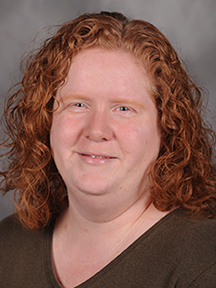 Karen F. Gracy joined the faculty of the School of Library and Information Science of Kent State University as assistant professor in 2007, where she teaches courses in digital preservation, digital curation, and audiovisual archiving. She possesses an MLIS and PhD in Library and Information Science from the University of California, Los Angeles, and an MA in Critical Studies of Film and Television from UCLA. Her book, Film Preservation: Competing Definitions of Value, Use, and Practice, was published by the Society of American Archivists in 2007. Other recent publications include “Distribution and Consumption Patterns of Archival Moving Images in Online Environments” (American Archivist, Fall/Winter 2012), “Ambition and Ambivalence: A Study of Professional Attitudes Toward Digital Distribution of Archival Moving Images” (American Archivist, Fall/Winter 2013), and “The Evolution and Integration of Moving Image Preservation Work in Cultural Heritage Institutions” (Information & Culture, August/September 2013).
Karen F. Gracy joined the faculty of the School of Library and Information Science of Kent State University as assistant professor in 2007, where she teaches courses in digital preservation, digital curation, and audiovisual archiving. She possesses an MLIS and PhD in Library and Information Science from the University of California, Los Angeles, and an MA in Critical Studies of Film and Television from UCLA. Her book, Film Preservation: Competing Definitions of Value, Use, and Practice, was published by the Society of American Archivists in 2007. Other recent publications include “Distribution and Consumption Patterns of Archival Moving Images in Online Environments” (American Archivist, Fall/Winter 2012), “Ambition and Ambivalence: A Study of Professional Attitudes Toward Digital Distribution of Archival Moving Images” (American Archivist, Fall/Winter 2013), and “The Evolution and Integration of Moving Image Preservation Work in Cultural Heritage Institutions” (Information & Culture, August/September 2013).
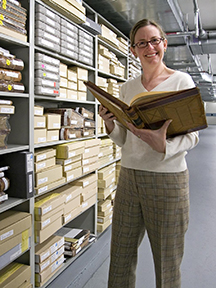 Sarah Stauderman is the collections care manager at the Smithsonian Institution Archives where she oversees its archives conservation services and historic photograph holdings. Sarah’s major research interest has been in the area of magnetic media deterioration and preservation management. She was among the first conservators to look at videotape in its object form and has lectured widely on the identification and care of magnetic tape formats. She has an MA from the Art Conservation Program at Buffalo State College, specializing in paper conservation, and was a post-graduate fellow at the Smithsonian Center for Materials Research and Education. Sarah has published a paper on the many different types of audio signal carriers for the Association of Research Libraries.
Sarah Stauderman is the collections care manager at the Smithsonian Institution Archives where she oversees its archives conservation services and historic photograph holdings. Sarah’s major research interest has been in the area of magnetic media deterioration and preservation management. She was among the first conservators to look at videotape in its object form and has lectured widely on the identification and care of magnetic tape formats. She has an MA from the Art Conservation Program at Buffalo State College, specializing in paper conservation, and was a post-graduate fellow at the Smithsonian Center for Materials Research and Education. Sarah has published a paper on the many different types of audio signal carriers for the Association of Research Libraries.
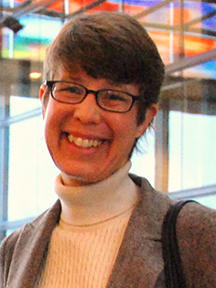 Linda Tadic is executive director for the Audiovisual Archive Network, an independent nonprofit digital library and preservation service for historical sound and moving image collections. She consults and lectures on digital asset management, audiovisual and digital preservation, and metadata with clients as diverse as WNET/Thirteen, PBS NewsHour, the Academy of Motion Picture Arts and Sciences, SBS (Australia), Dunhuang Academy (China), and the Missouri History Museum. From 2004 to 2011, Linda was an adjunct professor in NYU’s Moving Image Archiving and Preservation graduate degree program, teaching core courses in collections management, cataloging, and metadata. Linda’s more than 25 years of experience working with and managing audiovisual, digital, and broadcasting collections also includes positions at Home Box Office (HBO) as manager of the digital library, director of Media Archives and Peabody Awards Collection at the University of Georgia, and director of operations for ARTstor. She is also the past president of the Association of Moving Image Archivists (AMIA).
Linda Tadic is executive director for the Audiovisual Archive Network, an independent nonprofit digital library and preservation service for historical sound and moving image collections. She consults and lectures on digital asset management, audiovisual and digital preservation, and metadata with clients as diverse as WNET/Thirteen, PBS NewsHour, the Academy of Motion Picture Arts and Sciences, SBS (Australia), Dunhuang Academy (China), and the Missouri History Museum. From 2004 to 2011, Linda was an adjunct professor in NYU’s Moving Image Archiving and Preservation graduate degree program, teaching core courses in collections management, cataloging, and metadata. Linda’s more than 25 years of experience working with and managing audiovisual, digital, and broadcasting collections also includes positions at Home Box Office (HBO) as manager of the digital library, director of Media Archives and Peabody Awards Collection at the University of Georgia, and director of operations for ARTstor. She is also the past president of the Association of Moving Image Archivists (AMIA).
 Jeff Martin is an archivist and conservator with experience in caring for both archival collections and time-based art. A 2005 graduate of New York University’s Moving Image Archiving and Preservation MA program and a 2007 post-graduate research fellow at the Smithsonian Institution’s Hirshhorn Museum and Sculpture Garden, Jeff currently serves as executive director of Independent Media Arts Preservation (IMAP), a nonprofit organization dedicated to providing resources for the care of independently produced electronic media. His other recent projects include ongoing work as time-based art conservator for the Hirshhorn as well as collections assessments for the Seattle Art Museum, the Carnegie Museum of Art in Pittsburgh, the Science Museum of Minnesota, and the Corporation for Public Broadcasting. He served for two years as program chair for the Electronic Media Group (EMG) of the American Institute for Conservation and organized the EMG-sponsored workshop “TechFocus II: Caring for Film and Slide Art” in April 2012. He also supervised preservation content for the online Media Art Resource co-developed by Electronic Arts Intermix and IMAP. Before attending NYU, he worked as a television documentary writer and producer and as research director for the WPA Film Library.
Jeff Martin is an archivist and conservator with experience in caring for both archival collections and time-based art. A 2005 graduate of New York University’s Moving Image Archiving and Preservation MA program and a 2007 post-graduate research fellow at the Smithsonian Institution’s Hirshhorn Museum and Sculpture Garden, Jeff currently serves as executive director of Independent Media Arts Preservation (IMAP), a nonprofit organization dedicated to providing resources for the care of independently produced electronic media. His other recent projects include ongoing work as time-based art conservator for the Hirshhorn as well as collections assessments for the Seattle Art Museum, the Carnegie Museum of Art in Pittsburgh, the Science Museum of Minnesota, and the Corporation for Public Broadcasting. He served for two years as program chair for the Electronic Media Group (EMG) of the American Institute for Conservation and organized the EMG-sponsored workshop “TechFocus II: Caring for Film and Slide Art” in April 2012. He also supervised preservation content for the online Media Art Resource co-developed by Electronic Arts Intermix and IMAP. Before attending NYU, he worked as a television documentary writer and producer and as research director for the WPA Film Library.
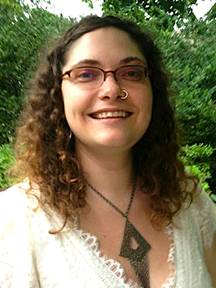 Stephanie Renne is the archivist and audiovisual specialist at George Blood Audio and Video. She has worked in a variety of academic and public libraries, archives, and non-traditional library settings. Stephanie began her globe-spanning career in the music library of the University of Illinois at Urbana-Champaign (UIUC). She studied music abroad in Senegal, learning to play traditional instruments. While earning a Masters in Library and Information Science and African Studies, she aided in the installation and design of a network computer system for the National Library in São Tomé and Príncipe. It was in Africa where she developed a passion for archiving. Returning to UIUC, she managed the Arms Control, Disarmament and International Security (ACDIS) Library and worked on projects with the archives at the Urbana Free Library and the Katherine Dunham Museum. Stephanie then ventured out to Maine where she served as a reference librarian for the Patten Free Library, processed the Strout Photography Collection at Bowdoin College Archives, and aided in development of Librarything.com, a cataloging and social networking site for booklovers. On the west coast, Ms. Renne independently managed the Pacific Basin Institute Archive at Pomona College in Claremont, California, an Asian studies film archive for which she built a new on-campus facility before returning east to join the preservation team at George Blood.
Stephanie Renne is the archivist and audiovisual specialist at George Blood Audio and Video. She has worked in a variety of academic and public libraries, archives, and non-traditional library settings. Stephanie began her globe-spanning career in the music library of the University of Illinois at Urbana-Champaign (UIUC). She studied music abroad in Senegal, learning to play traditional instruments. While earning a Masters in Library and Information Science and African Studies, she aided in the installation and design of a network computer system for the National Library in São Tomé and Príncipe. It was in Africa where she developed a passion for archiving. Returning to UIUC, she managed the Arms Control, Disarmament and International Security (ACDIS) Library and worked on projects with the archives at the Urbana Free Library and the Katherine Dunham Museum. Stephanie then ventured out to Maine where she served as a reference librarian for the Patten Free Library, processed the Strout Photography Collection at Bowdoin College Archives, and aided in development of Librarything.com, a cataloging and social networking site for booklovers. On the west coast, Ms. Renne independently managed the Pacific Basin Institute Archive at Pomona College in Claremont, California, an Asian studies film archive for which she built a new on-campus facility before returning east to join the preservation team at George Blood.

